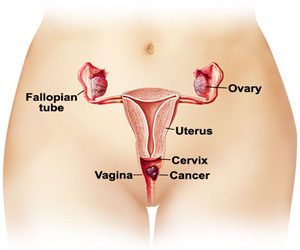| |
| What is Cervical Cancer ? |
| ----------------------------------------------------------------------------------------------------------------------------------------------------------------------------------------------------------------------- |
| |
The cervix is the lower part of uterus (womb). The cervix connects the body of uterus to the vagina (birth canal). Most cervical cancers begin in the cells lining the cervix. These cells do not suddenly change into cancer. Instead, the normal cells of the cervix first gradually develop pre-cancerous changes that turn into cancer. About 80% to 90% of cervical cancers are squamous cell carcinomas. |
|
| |
| |
| |
| What are the risk factors of Cervical Cancer ? |
| ----------------------------------------------------------------------------------------------------------------------------------------------------------------------------------------------------------------------- |
| |
 |
Several risk factors increase your chance of developing cervical cancer. Women without any of these risk factors rarely develop cervical cancer. Although these risk factors increase the odds of developing cervical cancer, many women with these risk factors do not develop cervical cancer.
Cervical cancer risk factors include-
1. Human papilloma virus infection- the most important risk factor for cervical cancer.
About two thirds of all cervical cancer are caused by HPV 16 and 18.
2. Smoking- Women who smoke are twice as likely as non-smokers to get cervical cancer.
3. Poverty- cervical cancer is common among poor rural women. |
|
| |
4. Young age at the first full term pregnancy- Women who were younger than 17 years when they had their first full term pregnancy are almost 2 times more likely to get cervical cancer later in life than women who waited to get pregnant until they were 25 years or older. |
| |
5. Multiple sexual partners. |
| |
6. Diet- Women whose diets donít include enough fruits and vegetables may be at increased risk for cervical cancer. Overweight women are more likely to develop cervical cancer. |
| |
7. Multiple term pregnancies- Women who have had 3 or more full term pregnancies have an increased risk of developing cervical cancer. |
| |
8. Immunosuppresion- The immune system is important in destroying cancer cells and slowing their growth and spread.Women receiving drugs to suppress immune system such as those being treated for an autoimmune disease or those who have had an organ transplant or women with HIV infection are at increased risk of developing cervical cancer. |
| |
| |
| |
| What are the symptoms ? |
| ----------------------------------------------------------------------------------------------------------------------------------------------------------------------------------------------------------------------- |
| |
Cervical cancer can usually be found early by having regular screening with a Pap test. Women with early cervical cancers usually have no symptoms. Symptoms often do not begin until the cancer becomes invasive and grows into nearby tissue. When this happens, the most common symptoms are- |
| |
- Abnormal vaginal bleeding such as bleeding after vaginal intercourse, bleeding after menopause, bleeding and spotting in between periods, having menstrual periods that are longer or heavier than usual.
- An unusual discharge from the vagina Ė the discharge may contain some blood and may occur between your periods or after menopause.
- Pain during intercourse.
|
 |
|
| |
| These symptoms can also be caused by conditions other than cervical cancer. For example an infection can cause pain or bleeding. Still, if you have any of these suspicious symptoms you should consult your doctor. Ignoring symptoms may allow the cancer to progress to a more advanced stage and lower your chance for effective treatment. |
| |
| |
| |
| How is Cervical Cancer diagnosed ? |
| ----------------------------------------------------------------------------------------------------------------------------------------------------------------------------------------------------------------------- |
| |
Cervical cancer is diagnosed by colposcopic biopsy from abnormal areas of cervix. Colposcope has magnifying lenses that allow doctors to see the surface of the cervix closely and clearly. |
| |
Doctor may also need to do cystoscopy (examination of bladder), proctoscopy (examination of rectum) and examination under anaesthesia to ascertain extent of involvement. |
| |
| Imaging studies like chest x-ray, CT scan or PET-CT scan are carried out to exclude spread of the cancer. |
| |
| |
| |
| Please explain the possible methods of Treatment. |
| ----------------------------------------------------------------------------------------------------------------------------------------------------------------------------------------------------------------------- |
| |
| The option for treating each patient with cervical cancer depend on the stage of disease. The stage of a cancer describes its size, depth of invasion (how far it has grown into the cervix) and how far it has spread. After establishing the stage of cervical cancer , doctor will recommend most appropriate treatment options. Cervical cancer can affect your sex life and your ability to have children. These concerns should also be considered as you make treatment decisions. |
| |
|
Common types of treatment for cervical cancer include-
1. Surgery
2. Radiation therapy
3. Chemotherapy
Often a combination is used. |
 |
|
| |
| |
| |
| What is the role of radiotherapy in curing Cervical Cancer ? |
| ----------------------------------------------------------------------------------------------------------------------------------------------------------------------------------------------------------------------- |
| |
|
Radiotherapy along with chemotherapy can cure cervical cancer. Radiation therapy uses high energy x-rays to kill cancer cells. These x-rays can be given externally called external beam radiation therapy. In cervical cancer, this type of radiotherapy is often given along with low doses of chemotherapy with a drug called cisplatin.
Another type of radiation therapy is called brachytherapy or internal radiation therapy. Radioactive materials is placed in a small metal tube near the cevix. A patient with cervical cancer usually requires both external and internal radiation therapy. |
|
| |
| |
| |
| Is surgery the only option ? When does it become mandatory ? |
| ----------------------------------------------------------------------------------------------------------------------------------------------------------------------------------------------------------------------- |
| |
Surgery is carried out in precancerous stage and in early stage of cervical cancer. When cervical cancer involves tissues around the cervix then surgery alone may not cure the cancer but radiation therapy along with low dose chemotherapy can cure the patient without surgery. So, surgery is not the only option. |
| |
| |
| |
| Is there any post treatment care? |
| ----------------------------------------------------------------------------------------------------------------------------------------------------------------------------------------------------------------------- |
| |
| After your treatment ends, it is important to go to all of your follow-up appointments so that your doctor has the opportunity to examine you and help you with treatment related side effects and can also detect recurrence of cancer early if that happens. |
| |
| |
| |